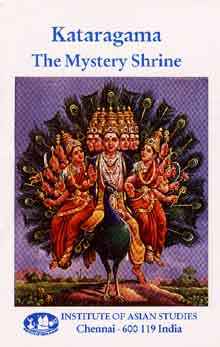|
| ||||
Pilgrim's Progress
Book review of Kataragama: The Mystery ShrineBook review by Dr. S. Suresh published in the Indian Review of Books
from The Hindu of Sunday, February 20, 2000 This is a unique book that combines in itself theoretical insights and empirical data, subtle humour and scholarly analysis. The book is thus ideal for both the breakfast table and the university library. The book deals with temple-town of Kataragama hidden within the thick tropical forests of Sri Lanka. The author is an American scholar who has lived for a long time in Sri Lanka and India. He has adopted the difficult, and unenviable, life of a devout researcher in the fields of Hindu religion and philosophy. The book is the outcome of his "long and slow" research spanning 28 eventful years. It was released at the First International Conference on Skanda-Murukan held in Chennai in December 1998. Unlike the usual books on temples and pilgrim centres, this volume does not furnish a monotonous, chronological account of the geography, history, religion and art of Kataragama. The book consists of eleven essays, each dealing with the town and its temple from varied perspectives. Most of the essays have been published earlier in newspapers or academic journals. The essays were written on different occasions and for varied "audiences". Hence, each essay is independent of the rest and certain facts and ideas are repeated. Conservative academicians may view this as a defect of the book, but then this is one of the many things that make this volume unique. Kataragama is a small sleepy township whose only claim to importance is its temple dedicated to Skanda or Murugan, well-known God of love and war. The temple is not large and impressive but is extremely popular and powerful. The book describes the numerous philosophical concepts, myths, legends, rituals and festivals associated with the temple. A major event in the temple's annual calendar is the processional pilgrimage, called pada yatra or 'journey on foot'. Devotees attach great importance to this pilgrimage. It is believed that it was first initiated by the island's forest-dwellers known as Veddas. the pilgrimage starts from the northern tip of the island. Braving hunger and thirst, the scorching sun and the pouring rain, people walk barefoot through long stretches of jungles infested with poisonous bushes, wild beasts and robbers. Not surprisingly, many die en route. Such a death is reckoned to be an exceptional distinction for which many pray fervently. The pilgrims usually travel in groups headed by a group-leader who is known as the Vel Swami because he carries the vel or spear, the weapon of Lord Murugan. The leader would have performed the pilgrimage in earlier years too and is expected to direct the route along forests where even the most experienced can easily get lost. Traditionally, a group consists of around thirty people but in recent years, for security reasons, the group is much larger. The pilgrims halt and pray at many important temples along the route. The journey lasts for nearly two months and finally terminates at the Katargama shrine in southeastern Sri Lanka. Arunagirinathar, the famous 15th century saint-singer from South India, is reported to have undertaken this pilgrimage. He has composed fourteen Tiruppukazh songs in praise of Lord Murugan of Kataragama. The author ably analyses the impact of modern ideas and technologies on traditional practices and customs. For example, prior to 1950 - when a motorable road was built to Kataragama - only pilgrims visited the shrine. But now one finds even even casual visitors and tourists. The place which was once calm and serene has now acquired a carnival-like atmosphere. Old-time pilgrims do not appreciate this change but explain it as the will of Murugan who also knows how to adjust to modernity. The most interesting essay is the one on the police personnel posted at Kataragama. They not only control the crowds and help the poor and the infirm among the devotees, but also participate in the ceremonies. During the annual 16-day festival, police officials of all ranks dance together, barefoot, to the beat of kavadi music. Hindus, Muslims and Buddhists all take part in the festival. The book has goaded me, as it will all other readers, to visit Kataragama. Online chapters from Kataragama: The Mystery Shrine
|
|
